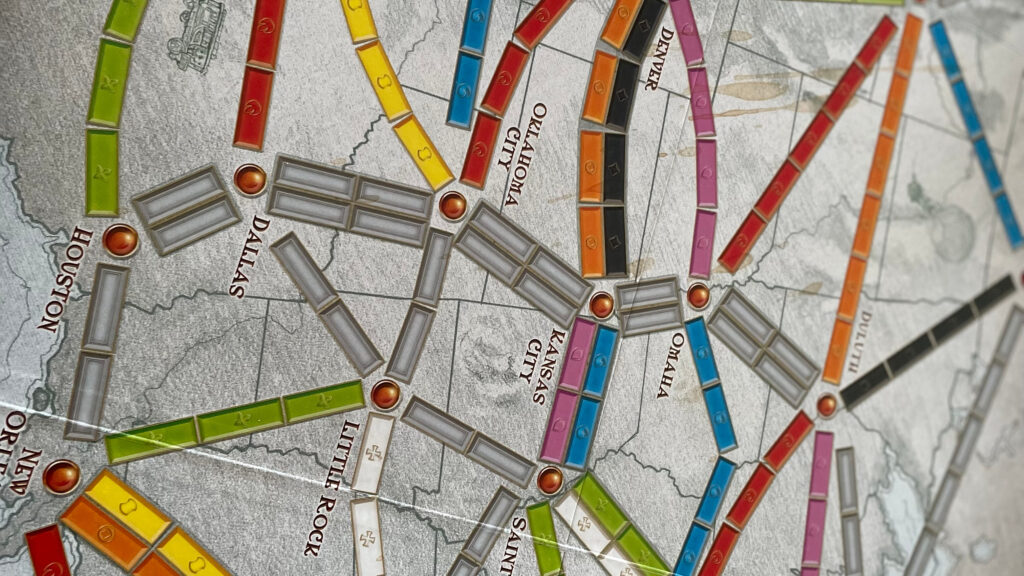Ticket to Ride is a beloved board game that combines strategy, planning, and a bit of luck. As players build railway routes across various regions, they compete to complete destination tickets and connect cities. While the rules are simple to grasp, mastering the game requires a deep understanding of tactics and efficient resource management. In this guide, we’ll delve into the strategies and techniques that will help you become a formidable Ticket to Ride player.
Understanding the Basics
Ticket to Ride is played on a board depicting a map of various regions, such as North America, Europe, or Asia. Players collect colored train cards to claim routes between cities, earning points for each route completed. The game also features destination tickets, which players must fulfill by connecting specific cities within a set number of turns.
Components
- Game Board: The board depicts a map of North America, divided into various regions and cities connected by railway routes.
- Train Car Cards: These cards come in different colors corresponding to the different types of routes on the board. They represent the resources needed to claim routes.
- Destination Ticket Cards: These cards specify two cities that players must connect with a continuous route to earn points. They come in various point values.
- Train Stations: These are optional pieces used in some versions of the game, allowing players to use opponents’ routes to complete their destination tickets.
- Scoring Markers: These are used to track players’ scores throughout the game.
- Bonus Points Cards: Some versions of the game include bonus points cards for completing specific criteria, such as longest continuous route or most destination tickets completed.
Setup
- Board Placement: Place the game board in the center of the table where all players can easily reach it.
- Train Car Cards: Shuffle the train car cards and deal a starting hand to each player. The number of cards in the starting hand can vary depending on the number of players.
- Destination Tickets: Shuffle the destination ticket cards and deal a specific number of cards to each player, usually three or four. Players can choose to keep all, some, or none of these cards.
- Scoring Markers: Each player selects a scoring marker and places it on the starting space of the scoring track.
- Train Stations (Optional): If using train stations, distribute them to each player according to the rules of the specific version being played.
- Bonus Points Cards (Optional): If using bonus points cards, place them near the game board where all players can see them.
Players Turn
In Ticket to Ride, each player’s turn offers several options, providing strategic choices to advance their position and ultimately win the game. Here are the typical options available on a player’s turn:
1. Draw Train Car Cards:
- Players can draw train car cards from the face-up display or the top of the draw deck.
- They can take two cards of different colors or one wild card (rainbow card) from the face-up display.
- Alternatively, players can draw blindly from the top of the draw deck, taking just one card.
2. Claim a Route:
- Players can use the train car cards in their hand to claim a route on the board.
- To claim a route, players must play a set of cards matching the color and length of the route they want to claim.
- The number of cards required depends on the length of the route being claimed.
- For grey (wildcard) routes, players can use any set of cards of the same color to claim the route.
3. Draw Destination Tickets:
- Players can draw additional destination ticket cards to add to their existing ones.
- They draw three destination ticket cards from the top of the deck and must keep at least one of them.
- These cards represent new routes players can aim to complete for additional points.
4. Build a Train Station (Optional):
- If using train stations in the game variant being played, players can choose to build a train station on their turn.
- Train stations allow players to use one of their opponent’s routes to complete a destination ticket.
5. Discard Destination Tickets (Optional):
- Players can choose to discard one or more of their existing destination tickets.
- This option can be useful if players find they have destination tickets they are unlikely to complete or if they want to focus on other routes.
6. Pass (Rarely Used):
- If none of the other options are appealing or viable, players can choose to pass their turn.
- Passing is uncommon since players typically want to take actions that progress their position in the game.
These options provide players with the flexibility to adapt their strategy based on the cards available, the routes they aim to claim
Choosing Your Destination Tickets Wisely
One of the critical elements of Ticket to Ride is selecting destination tickets that complement your strategy. Aim for routes that are easily achievable based on the initial layout of the board and your starting train cards. Avoid overly ambitious routes that may be challenging to complete, especially in the early stages of the game. Prioritize destination tickets that connect cities along existing routes or ones that can be easily extended.
Balancing Short and Long Routes
Striking a balance between short and long routes is essential for success in Ticket to Ride. Short routes can provide quick points and help you establish early connections on the board. Long routes, on the other hand, offer substantial point bonuses but require careful planning and resource management. Aim to claim a mixture of both short and long routes to maintain flexibility in your strategy.
Strategic Card Management
Efficient card management is key to executing your strategy effectively in Ticket to Ride. Pay attention to the colors of the routes you aim to claim and prioritize collecting the corresponding train cards. Additionally, consider hoarding wild cards (rainbow cards) strategically, as they can be used to fill gaps in your route or block opponents from claiming critical paths.
Blocking and Denying Routes
In Ticket to Ride, blocking your opponents’ routes can significantly disrupt their plans and give you a competitive edge. Pay attention to your opponents’ destination tickets and try to anticipate which routes they may be aiming to claim. Strategically placing your trains to block key connections can force your opponents to take longer routes or abandon their plans altogether.
Adapting to Changing Circumstances
Flexibility is crucial in Ticket to Ride, as the game board evolves with each player’s turn. Be prepared to adjust your strategy based on the cards available, your opponents’ actions, and the progress of the game. Stay vigilant for opportunities to capitalize on unexpected openings or to thwart your opponents’ plans.
Timing Your Endgame
As the game nears its conclusion, carefully assess your remaining destination tickets and the feasibility of completing them. Consider whether it’s more advantageous to focus on claiming additional routes or to prioritize completing existing ones. Keep an eye on your opponents’ progress and be prepared to adjust your plans accordingly to maximize your final score.
Conclusion
Ticket to Ride offers a rich and engaging gameplay experience that rewards strategic thinking and careful planning. By mastering the fundamentals of route building, card management, and adaptation, you can become a formidable player capable of outmaneuvering your opponents and claiming victory on the rails. With practice and perseverance, you’ll discover new depths of strategy and enjoyment in this timeless board game.






